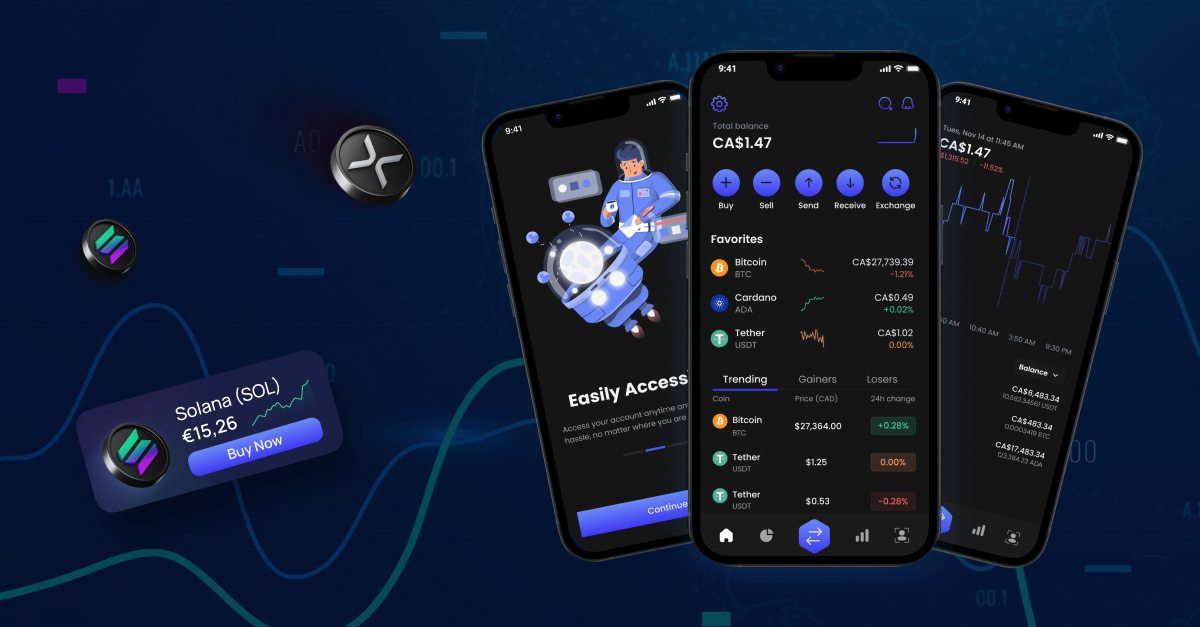The question of “what is a neobank” is intriguing users and developing a heightened interest in digital financial institutions. Our article will explore neobanks as a phenomenon, their operational processes, unique strengths, dissimilarities from traditional banks, and how to start a neo bank.
By 2030, the neobank market will be valued at $2,048.54 billion.
 CAGR of 54.8%
CAGR of 54.8%
The Neobank market is forecast to grow at a CAGR of 54.8% from 2023 to 2030.
 51.0%
51.0%
As of 2022, enterprises’ segment account for 51% of global neobanks revenue.
What Is a Neobank?
A neobank definition describes neobank as a financial technology company that exclusively offers banking services online, without physical branches. They commonly provide various financial products, including checking and savings accounts, credit and debit cards, loans, and money transfers, via mobile applications and websites.
Neobanks typically concentrate on specific customer segments like millennials, small businesses, or underbanked populations. They aim to deliver a more convenient, transparent, and personalized banking experience than traditional banks. Neobanks collaborate with established banks to gain access to banking infrastructure and regulatory licenses. They also prioritize developing innovative customer-facing technologies and business models.

How Do Neobanks Work?
Neobanks are innovative financial institutions that offer banking services through mobile and web applications. They use APIs to integrate with third-party providers, such as payment gateways, and store data in the cloud to ensure scalability. Big data analytics explores customer behavior, and artificial intelligence is used to automate banking processes and fraud transaction detection.
Some neobanks also use blockchain technology to guarantee secure, transparent, and tamper-proof customer transactions. For instance, neobanks can use this technology to enable peer-to-peer (P2P) transfers, which allow customers to send and receive money instantly and securely. Such Transfers are decentralized and do not require intermediaries or authorities to facilitate and validate transactions.
Biometrics and digital authentication technology enable wearable devices to read unique information, including fingerprints, facial patterns, or voices. This facilitates speedy registration and verification of users in a system, establishing a more credible proof of identity than easily forged documents.
Explore our FinTech expertise and find out how Interexy can help you!
Book a call with our expertsWhy Are Neobanks Popular?
Neobanks have advantages that allow them to offer potential users more favorable conditions than traditional or online banks.
1. Convenience
Neobanks provide customers with the convenience of opening accounts online and avoiding the need to visit a bank or fill out paper forms physically. So, Deposits and withdrawals can also be easily made through mobile apps or websites.
Moreover, mobile apps and websites offer access to 24/7 live chat and email customer support. A benefit of neobanks is their diverse financial management tools and features, including the ability to categorize payments, establish savings targets, and track expenses.
2. Lower Fees
Neobanks typically charge lower fees than traditional oness since they lack the overhead costs of operating physical branches. This allows them to offer customers more competitive rates.
The digitization of processes and the absence of paperwork allows neobanks to keep fewer employees, which also affects the prices of services provided in a positive way for the client. Additionally, some neobanks provide fee-free transactions, making them an appealing option for individuals seeking cost-effective banking solutions.
3. Speed
Neobanks exist in a digital environment, so they do not have a bureaucratic burden during processing. Transactions can be completed much more quickly using blockchain than with traditional banking methods.
Neobank institutions that utilize blockchain automation can achieve high speeds by eliminating the need for third-party validation of each transaction through smart contract technology. This innovative solution enables contracts and agreements to be replaced with an executable script that requires no further validation once the requirements have been met.
4. Advanced Technology
Neobanks invest heavily in advanced technologies like artificial intelligence, machine learning, and blockchain. For example, some neobanks use AI-powered chatbots to provide 24/7 customer support, while others use blockchain technology for secure and transparent transactions.

Popular Neobanks
-
Chime
Chime is one of the popular neobanks in the US that provides free-of-charge banking services devoid of overdraft fees, monthly maintenance fees, or minimum balance requirements. It is also the top neobank stock market representative with the highest market capitalization of about $25 billion. Additionally, Chime boasts a remarkable feature dubbed “SpotMe,” which permits qualifying patrons to exceed their account’s balance by up to $200 without incurring any fees.
-
Varo Bank
Varo Bank is one of the top neobanks in the US and provides checking and savings accounts and a credit card option. Early direct deposit is available, and customers can benefit from a cashback rewards program for debit card purchases. Varo Bank strives to offer affordable banking services to individuals who lack access to traditional options.
-
Current
This American neobank platform provides a checking account and Visa debit card with instant notifications, early direct deposit, and budgeting tools. Additionally, Current collaborates with merchants to offer cashback rewards for purchases made with the debit card.
-
International Challenger Banks
International Challenger Banks allow customers to manage their finances worldwide through mobile apps and online banking platforms. In most common cases, neo bank vs challenger bank means that the challenger does have a license to offer all kinds of banking services. Well-known examples of these banks are Revolut, Monzo, and Atom.
-
Revolut
Revolut, a UK-based challenger bank launched in 2013, provides fully digital banking services through a mobile app or website. It is available in over 200 countries worldwide and has over 15 million customers.
-
Atom
Atom Bank was founded in 2014 and offers mobile banking services in the UK. It uses machine learning to analyze customer data and provide personalized recommendations and information.
-
Monzo
Monzo, a UK-based Challenger Bank, was established in 2015 to provide customers with digital banking services through its mobile app. Additionally, it offers an automatic rounding feature for transaction amounts and integration with third-party apps, including budgeting tools and investment platforms.
Neobanks vs. Online Banks
In neobank vs digital bank (online bank) struggle are both digital financial institutions that offer banking services through online platforms, but there are some critical differences between them. And the main one is the level of innovation that neobanks bring to the industry.
Neobanks are a newer type of financial institution that has emerged recently. They are typically startup companies that use technology to provide innovative and customer-centric banking services. Often targeting niche markets or underserved populations, neobanks frequently offer features like fee-free accounts, early access to direct deposits, and mobile app-based banking.
Online banks, on the other hand, have been around for longer and are typically subsidiaries of traditional brick-and-mortar banks. They offer similar services to traditional banks, such as checking and savings accounts, loans, and credit cards, but they operate entirely online without physical branches. Typically, online banks offer competitive interest rates and lower fees when compared to traditional banks.

Is a Neobank Better Than a Traditional Bank?
Neobanks are banks that operate digitally without any physical branches and provide most of the services traditional banks offer. They can be a more attractive alternative for customers due to their lower fees and higher deposit interest rates than traditional banks.
Additionally, neo banking meaning is tightly tailored to advanced technologies, so neobanks use modern encryption and authentication technologies. They are also more open to integrating with fintech solutions, allowing them to offer customers a more comprehensive range of services.
Conversely, traditional banks present a broader spectrum of services and are often equipped with more powerful customer support options, including in-person assistance at physical branches. They may also offer more extensive credit options and investment opportunities.
At last, the decision to opt for either a neobank or a traditional bank hinges on personal needs and preferences. When choosing between a neobank and a traditional bank, it is essential to consider factors such as fees, account options, customer service, accessibility, and security.
Explore our FinTech expertise and find out how Interexy can help you!
Book a call with our expertsHow Do Neobanks Make Money?
Neobanks are relatively new to the financial industry, and their revenue models may evolve as they mature. Nevertheless, some common ways neobanks generate revenue include:
-
1 Interchange Fees
Like traditional banks, the neobank business model can generate revenue through interchange fees. These fees are charged to merchants when customers use debit or credit cards to make purchases, and the amount varies depending on the specific card network (such as Visa or Mastercard) and the type of transaction. Neobanks receive a portion of these fees as compensation for facilitating the transactions.
-
2 Interest on Deposits
Atom Bank was founded in 2014 and offers mobile banking services in the UK. It uses machine learning to analyze customer data and provide personalized recommendations and information.
-
3 Subscription Fees
Some neobanks charge subscription fees for premium services, such as access to financial planning tools or enhanced account features. Customers may utilize these services by paying monthly or yearly fees, which can aid neobanks in generating regular revenue.
-
4 Referrals and Partnerships
Neobanks may partner with financial companies or fintech startups to offer joint products or services. They may receive referral fees or commissions in certain instances due to these partnerships.
Should You Consider Switching to a Neobank?
Neobanks are increasingly popular due to the wide range of options available to customers. Account opening takes only a few minutes, making the process easier in neobanks vs traditional banks. Their user-friendly mobile apps provide customers with an exceptional experience.
Neobanks also allow for hassle-free international transactions, eliminating the need to undergo multiple procedures at a traditional bank. They also gather data for intelligent reports that assist customers in controlling their spending and managing their finances. Additionally, they utilize the latest technologies, such as artificial intelligence and machine learning, to offer more responsive and predictive services.
Overall, neobanks have great potential and provide innovative financial services that were previously unattainable for many customers, especially in comparison to traditional ones.

Interexy as a Leading Digital Development Provider
We provide digital software development services, including establishing private blockchains designed for financial transactions. Additionally, we create Web3 wallets as unique payment solutions and utilize various blockchain frameworks and networks, including Ethereum, Hyperledger Fabric, Graphene, and Polygon.
Our experts have deep expertise in healthcare, blockchain, fintech, and many other areas. They are prepared to share their knowledge and skills within ten business days of receiving your request.
Explore our FinTech expertise and find out how Interexy can help you!
Book a call with our expertsFAQs
-
What is a neobank?
A neobank is a fully digital financial institution that offers banking services without physical branches. The neobank meaning revolves around convenience, cost-efficiency, and innovation, using technology to provide seamless financial solutions. Key neobank features include seamless digital onboarding, AI-driven financial insights, instant transactions, and personalized banking experiences.
-
How does a neobank work?
A neobank operates entirely online, delivering banking services via mobile and web platforms. With lower operational costs than traditional banks, the neobank business model often focuses on offering personalized, user-friendly banking experiences. Customers can open accounts, make payments, access loans, and manage finances with minimal effort.
-
What is an example of a neobank?
There are many neobank examples worldwide, offering digital-first banking services without physical branches. Some of the most well-known include:
- Chime (US) – A popular neobank offering fee-free overdrafts, early direct deposits, and automatic savings tools.
- Varo Bank (US) – The first neobank to receive a national bank charter, providing high-yield savings and credit-building options.
- Revolut (UK/EU) – A global neobank with multi-currency accounts, cryptocurrency trading, and budgeting tools.
- N26 (Germany/EU) – A European neobank offering fee-free international transactions and real-time spending insights.
- Monzo (UK) – Known for its user-friendly app, instant notifications, and savings features.
- Starling Bank (UK) – A full-service digital bank with smart money management for personal and business accounts.
-
How do neobanks make money?
Neobanks follow a unique neobank business model, generating revenue through multiple streams:
- Interchange fees – Earning a small percentage of transactions made with their debit or credit cards.
- Subscription plans – Offering premium accounts with additional neobank features like cashback or investment tools.
- Lending services – Providing personal loans or overdraft facilities and earning interest.
- Wealth management – Some neobanks generate revenue through investment and crypto trading features.
-
How to start a neobank?
Starting a neobank involves several key steps:
- Market research & business model definition – Identify your target audience and key neobank features that will differentiate your service.
- Regulatory compliance – Partner with an existing bank or obtain a banking license.
- Neobank app development – Build a user-friendly mobile and web platform with secure transactions, AI-driven analytics, and fraud protection.
- Partnerships & integrations – Connect with payment processors, security providers, and fintech APIs.
- Launch & scale – Implement a marketing strategy and continuously improve based on user feedback.
-
How much does it cost to build a neobank?
The neobank development cost varies based on the complexity of the platform and required features. A basic neobank app development project can start at $100,000, while a fully-featured neobank with AI-driven analytics and compliance integrations may cost $500,000 or more.






